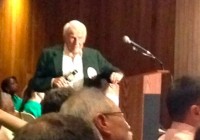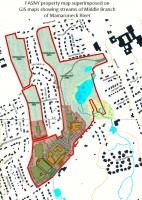FASNY Hearing Raises Hydrology Issues

The French American School of New York (FASNY) public hearings regarding a discontinuance of a portion of Hathaway Lane that runs through the school’s property and the special permit and site plan for the school development continued for the third and then fourth meeting on September 8th and 10th at the White Plains High School auditorium.
A special meeting scheduled for Monday, Sept. 29th will allow the White Plains Council to ask FASNY representatives questions related to issues brought up during the public hearings.
Record numbers of attendees were present; the auditorium was packed, indicating an audience of about 750 people.
An informal survey by this reporter indicated that the audience was represented almost 50/50 – pro FASNY development vs. those against – the green shirts vs. the red buttons, but the applause after each speaker seemed to show a greater presence by the anti-FASNY contingent.
Mayor Tom Roach followed public hearing protocol and maintained that everyone would get a chance to speak once during each of the hearings. Some members of the audience that had come prepared to speak, but who had already been to the podium, passed their comments on to other members of the audience for reading.
Following the recommendation by the White Plains Planning Board that the closing of a portion of Hathaway Lane was an unprecedented action in White Plains, especially the giving of public property in a residential neighborhood to a private organization, and that other options should be investigated before taking such action, members of the Gedney neighborhood expressed their fears about increased traffic on local roads should Hathaway Lane be closed.
White Plains residents spoke pro and con about the presence of FASNY in the neighborhood.
Neighbors and members of the White Plains PTA stated concern about increased traffic impacting the safety of children walking to and from neighborhood public schools, including White Plains High School, which is situated directly across the street from the proposed FASNY entrance on North Street.
Several members of the Gedney neighborhood said they would prefer a residential development to the building of a regional school campus on the grounds of the former Ridgeway Country Club.
A debate between real estate brokers argued the value of property in the immediate neighborhood and the affect FASNY would have and already was having on the sale of homes abutting the defunct golf course.

A presentation by Anne Bobroff-Hajal, a Gedney resident and member of a local Green activist group called EcoNeighbors, brought into question the presence of the middle branch of the Mamaroneck River on the FASNY property and the alleged origin of that branch from the large pond located on the property and in the proposed conservancy area.
Bobroff-Hajal told the White Plains Council that she had contacted the U.S. Army Corps of Engineers regarding the FASNY development, especially as it relates to hydrology issues connected to the Mamaroneck River and had heard back from them that they had interest in any development in the area.
The U.S. Army Corps of Engineers has begun research into flooding and underground river flow of the Mamaroneck and Sheldrake Rivers after the 100-year storms that created massive flooding and damage several years back.
FASNY representatives acknowledged that they had been in contact with the Corps in 2011 and that they would continue as required.
Bobroff-Hajal said none of FASNY’s maps included the underground middle branch of the river and that it was not mentioned in the FASNY FEIS.
An online search by The White Plains Examiner found one New York Times article and several online pieces dating back to the 1980s and earlier that indicated the history of the Mamaroneck River, situated in White Plains, included its historic use for drinking water and some milling operations. With the development of golf courses in the area, sections of the river were covered over and connected via stormwater systems running between the golf courses. The Mamaroneck River affects White Plains at Lake Street, in the Highlands neighborhood and into Harrison, with water flow both above and below ground.
The White Plains Council will hear comments from FASNY on September 29th. The public hearings have not yet been closed, and Mayor Roach indicated the public written comment period would continue after the hearings have been finalized and officially closed.
To view communications to the White Plains Council from the White Plains Planning Board, Department of Parking, and Design Review Board and the Westchester County Planning Board visit www.cityofwhiteplains.com.

